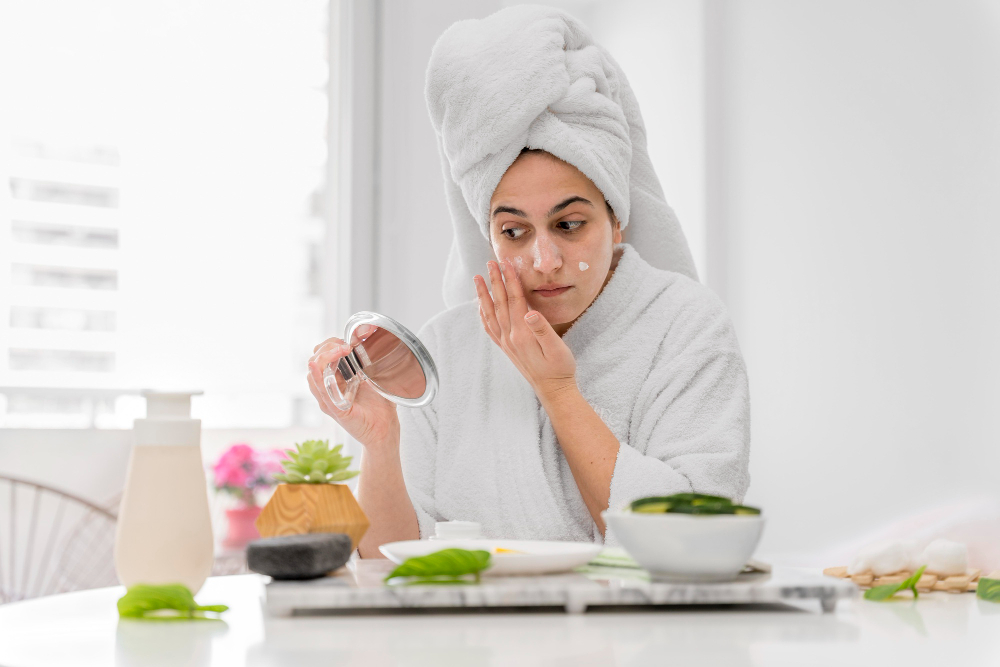Understanding Your Skin Type
Knowing your skin type is the first step to healthy skin care. Whether you have dry, oily, sensitive, combination, or normal skin, using the right products can help you address specific needs.
Identify Your Skin Type
To identify your skin type, try the bare-faced method. Start by washing your face with a gentle cleanser and pat it dry. After 30 minutes without applying any products, observe how your skin feels and looks. If it feels tight, you might have dry skin. If there’s noticeable shine on your forehead, nose, and chin, your skin is likely oily. Normal skin won’t feel tight or oily, while combination skin might have oily areas and dry patches. Sensitive skin may show redness or a tingling sensation.
Customizing Care for Dry, Oily, and Sensitive Skin
Dry Skin: Keep it moisturized. Opt for creams that help lock in moisture. Look for ingredients like hyaluronic acid or glycerin.
Oily Skin: Choose non-comedogenic products to prevent clogged pores. Gel-based cleansers or lightweight moisturizers work well. Blotting papers can help manage excess oil throughout the day.
Sensitive Skin: Be gentle with your skincare routine. Pick products with minimal ingredients and avoid fragrances or harsh chemicals. Look for soothing ingredients like aloe vera or chamomile.
Dealing With Combination and Normal Skin
Combination Skin: Focus on treating different areas according to their needs. Use balancing products that can hydrate dry areas while controlling oil in the T-zone. Consider a gentle cleanser and a balancing toner.
Normal Skin: Although it might not require special attention, maintaining balance is key. A simple routine with a gentle cleanser, moisturizer, and sunscreen will keep it healthy. It’s still important to adjust based on the environment or any changes your skin may experience.
By understanding your skin type, you can ensure that you’re using the right products to help your skin look and feel its best.
Daily Skin Care Essentials
Taking care of your skin every day helps keep it healthy. This includes regular cleaning, keeping your skin moisturized, and protecting it from the sun. These steps ensure your skin stays fresh and well-protected.
The Role of Cleansing
Cleansing your skin is a key step to rid your face of dirt, oil, and makeup. Using a gentle cleanser in the morning and at night helps keep your pores clear from buildup. Choose a cleanser that suits your skin type, whether it’s oily, dry, or sensitive.
Massage the cleanser onto your damp skin using your fingertips in a circular motion. Rinse thoroughly with lukewarm water. Using hot water can strip your skin of necessary oils. Pat your skin dry with a soft towel, avoiding harsh rubbing that can irritate your skin.
Importance of Moisturizing
Moisturizing helps keep your skin hydrated and protected. It’s a crucial part of any daily skin care routine and helps in maintaining your skin’s natural barrier. After cleansing your face, apply a hydrating moisturizer that’s suitable for your skin type.
For oily skin, opt for a lightweight, non-greasy moisturizer. If you have dry skin, choose a richer cream-based moisturizer. This helps prevent your skin from feeling tight and dry.Applying moisturizer helps lock in moisture, making your skin look plump and healthy. To complement your skincare routine, consider using Amazon castile soap as a gentle cleanser that nourishes your skin without stripping its natural moisture. To complement your skincare routine, consider using Amazon castile soap as a gentle cleanser that nourishes your skin without stripping its natural moisture.
Applying Sunscreen Regularly
Using sunscreen is important to protect your skin from harmful UV rays. Aim for a broad-spectrum sunscreen with at least SPF 30. Sunscreen should be applied every day, even on cloudy days, to protect your skin from sun damage and premature aging.
Apply sunscreen generously on all exposed parts of your skin about 15 minutes before you go outside. Don’t forget areas like your ears and neck. Reapply every two hours when you stay outside for long periods. This shields your skin from sunburns and long-term damage.
Addressing Common Skin Concerns
Taking care of your skin involves managing acne, minimizing scars and dark spots, reducing signs of aging, and preventing skin diseases. Let’s break down what you can do to address these common skin concerns.
Managing Acne and Blemishes
Acne can be a persistent issue. You can manage it by keeping your skin clean and using products with benzoyl peroxide or salicylic acid. These ingredients help unclog pores and reduce inflammation. Maintaining a balanced diet and avoiding excessive milk and sugar can also improve skin health.
Stress can worsen acne, so practice relaxation techniques. Severe acne might require visiting a dermatologist for expert advice or treatments like retinoids or prescription medications. Don’t forget to moisturize with products that are non-comedogenic to prevent clogging your pores.
Reducing Scars and Dark Spots
Scars and dark spots can be bothersome. To lighten dark spots and reduce scars, products with vitamin C, retinoids, or alpha hydroxy acids can be effective. These ingredients help in evening skin tone and texture.
Chemical peels or professional treatments may also help. For natural options, try aloe vera or rosehip oil to soften the appearance of scars. It’s important to apply sunscreen daily since sun exposure can darken spots. Seeing a dermatologist for persistent issues can be beneficial for more targeted treatments.
Combatting Signs of Aging
To combat wrinkles and age spots, start with a good skincare routine that includes Anti Aging Essentials designed to boost skin elasticity, smooth fine lines, and maintain a youthful glow.
Anti-aging creams with retinol, peptides, or hyaluronic acid boost skin elasticity and hydration. These help in smoothening fine lines and firming your skin.
Incorporate antioxidants like vitamin E to protect your skin from damage. Staying hydrated and avoiding smoking can also delay signs of aging. Professional treatments like laser therapy or fillers can be options for deeper wrinkles. Always use SPF daily to protect against UV rays, a major factor in aging.
Preventing and Treating Skin Diseases
Common skin diseases like eczema or rosacea need gentle care. Use soothing, unscented moisturizers to keep skin hydrated and avoid flare-ups. Managing stress and dietary changes can also help with skin conditions.
For serious concerns like skin cancer and melanoma, regular check-ups with a healthcare provider are key. Examine your skin for new changes or moles and consult professionals for early detection and treatment. People with vitiligo can benefit from therapies that address pigmentation issues, while avoiding known triggers helps manage skin conditions effectively.
You’ve learned some practical steps to address these common skin concerns, ensuring healthier, more vibrant skin.
Enhancing Skin Health Through Lifestyle
Improving your skin health involves making the right lifestyle choices. Eating a balanced diet, staying hydrated, getting enough sleep, exercising regularly, and reducing stress can all contribute significantly to keeping your skin looking healthy and vibrant.
Nutrition and Hydration
Your diet plays a huge role in your skin’s appearance. Eating plenty of fruits and vegetables gives your skin important vitamins and antioxidants.
Foods like nuts and fish provide healthy fats that help keep your skin cell membranes strong. Moreover, staying hydrated by drinking enough water aids in maintaining your skin’s elasticity and moisture. Tip: Aim for at least 8 glasses of water a day to support skin hydration and overall health.
Sleep and Exercise Benefits
Getting enough sleep is critical for skin repair and rejuvenation. Aim for 7-9 hours of quality sleep each night. This helps your body repair damaged skin cells, reducing the appearance of dark circles and puffiness.
Exercise improves blood flow, which nourishes skin cells and keeps them vital. Regular physical activity can also enhance your skin’s tone and texture by delivering more oxygen and nutrients.
Minimizing Stress and Skin Impact
Stress can trigger various skin issues like acne and eczema. Finding ways to manage stress is key to maintaining healthy skin. Techniques such as yoga, meditation, or deep breathing can help.
Establishing a regular skincare routine that includes cleansing and moisturizing can further minimize stress on your skin. Keep stress in check to support your skin’s natural glow and health.
Advanced Skin Care Techniques
To take your skin care routine to the next level, it’s important to focus on specialized techniques. This involves using products like serums and embracing professional treatments, as well as exploring innovative ingredients and trends.
Exploring Exfoliation and Serums
Exfoliating is key to removing dead skin cells and brightening your complexion. You can use physical exfoliants like scrubs or opt for chemical exfoliants with alpha hydroxy acids (AHAs) or beta hydroxy acids (BHAs). These help reveal smoother, fresher skin.
Serums are potent formulations that target specific concerns. Products with retinol can reduce fine lines, while vitamin C serums brighten and even out skin tone. Serums containing hyaluronic acid are perfect for deep hydration. Consider those with antioxidants and peptides to boost skin health and elasticity.
Professional Treatments and Consultations
Visiting a dermatologist can offer insights specific to your skin’s needs. They might recommend treatments like chemical peels or microdermabrasion to exfoliate deeper layers of skin. These procedures can improve texture and reduce blemishes.
Cosmetic treatments such as laser therapy can address issues like scars and pigmentation. Getting professional advice ensures you’re using the right skin care products that are non-comedogenic, meaning they won’t clog your pores. Regular consultations can keep your skin care regimen on track and effective.
Innovative Products and Ingredients
Stay updated with innovative products that incorporate unique ingredients. Natural oils like tea tree oil have antibacterial properties beneficial for acne-prone skin. Honey is a natural moisturizer and helps soothe irritation. Look for products that include niacinamide, known to reduce inflammation and even out skin tone.
Newer formulations might combine essentials like essential oils with advanced compounds to maximize benefits. When trying new products, consider doing a patch test first to ensure compatibility with your skin. Integrating these products into your routine can bring noticeable improvements.
Protecting Your Skin From the Sun
To keep your skin healthy, it’s important to minimize sun exposure. Using the right sunscreen, understanding UVA and UVB rays, and following sun safety tips are crucial.
Choosing the Right Sunscreen
When selecting sunscreen, SPF 30 or higher is recommended for effective protection. It helps guard against harmful UV rays. Look for labels with broad-spectrum protection to shield against both UVA and UVB rays.
Apply sunscreen generously 15-30 minutes before going outside. Reapply every two hours, or more often if swimming or sweating. Sunscreens come in lotions, creams, and sprays, so choose based on preference and skin type.
Understanding UVA and UVB Protection
UVA rays penetrate deeper into the skin and can cause aging and wrinkles. These rays are present year-round. They can even penetrate glass. UVB rays cause sunburn and vary in intensity depending on the season and time of day.
Broad-spectrum sunscreens protect against both UVA and UVB rays. Understanding this difference helps in selecting the right sun protection products. This can prevent skin damage over time.
Sun Safety Tips and Skin Cancer Prevention
When UV exposure is high, taking further precautions is vital. Seek shade during peak sun hours. Wear protective clothing like hats and sunglasses. This adds extra layers of sun protection.
Regular skin cancer screenings are essential for early detection. Many organizations offer free screenings to raise skin cancer awareness. Check your skin regularly for any changes, and consult a dermatologist if needed. Taking preventive steps now can protect you in the future.









